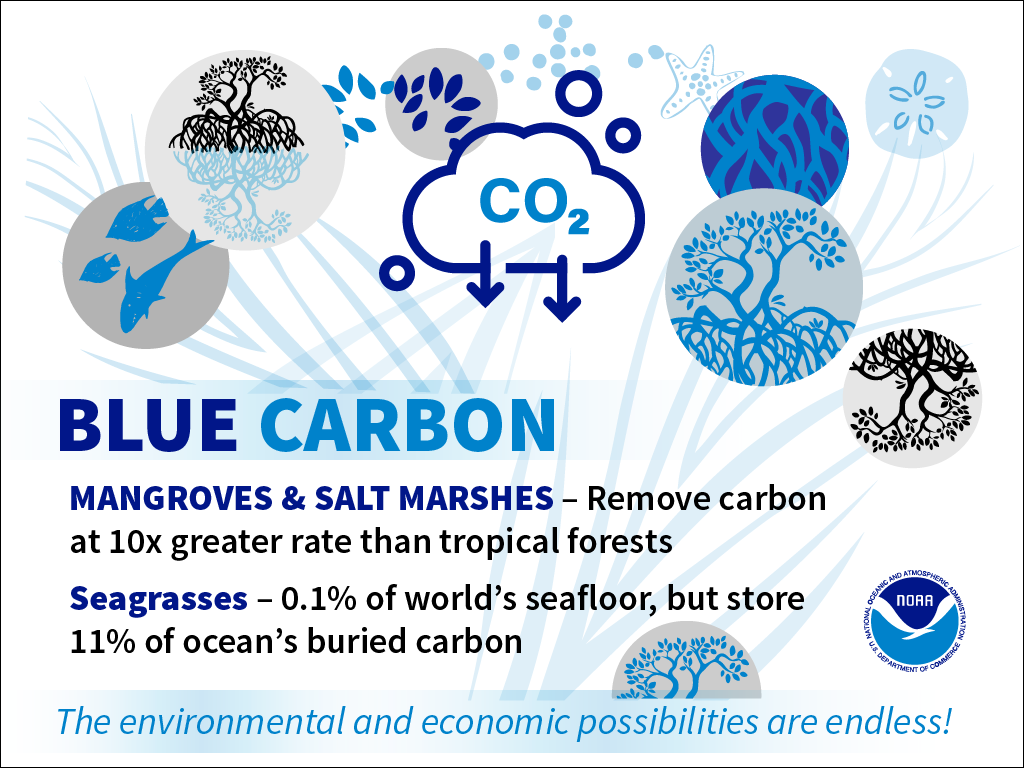Fast Facts / Blue Carbon
Blue Carbon
Our oceans and coasts provide a natural way of reducing the impact of greenhouse gases on our atmosphere through the sequestration (or taking in) of carbon. We call this “blue carbon.”
10 Times Greater Removal1
Mangroves and salt marshes remove carbon from the atmosphere at a rate 10 times greater than tropical forests.
11 Percent of Buried Carbon2
Seagrass meadows account for just 0.1 percent of the world’s seafloor but store 11 percent of the organic carbon buried in the ocean.
Up to Five Times More Storage1
Mangroves and salt marshes store three to five times more carbon per acre than tropical forests.
A Case for Saving Seagrasses3
An assessment of 215 studies found that approximately seven percent of the world’s seagrasses are being lost each year because of development, polluted runoff, climate change, and other factors. Abundant seagrasses foster carbon sequestration and help support coastal resilience, habitats, and economies.
Assessing the Potential4
Multiple NOAA-funded research and monitoring efforts have focused on blue carbon storage opportunities, and the benefits that could come from restoring coastal habitats. Below are just a few:
- The Waquoit Bay Research Reserve in Massachusetts developed “Bringing Wetlands to Market,” which included the first-ever U.S. tool and guide on marketing the blue carbon stores in wetlands. It also included a protocol to make salt marsh restoration eligible for carbon markets and a user-friendly model enabling managers to predict how tidal wetland greenhouse-gas fluxes, and potential carbon storage, will change under different conditions. The reserve and partners also found that restoring tidal flow to restricted or degraded marshes reduces the greenhouse gas methane. Moreover, the team found that restoring tidal flow from the Herring River to 1,100 acres of degraded wetlands is feasible and, over four decades, could prevent estimated carbon dioxide emissions of up to 300,000 tons from entering the atmosphere.
- In Florida, Rookery Bay Research Reserve and Restore America’s Estuaries are studying the feasibility of using a planned mangrove restoration to market blue-carbon credits. U.S. investors need to know how much carbon is stored in wetlands to confidently trade on the carbon market.
- Oregon’s South Slough and Washington’s Padilla Bay research reserves, working with the Pacific Northwest Coastal Blue Carbon Working Group—which was formed following “Bringing Wetlands to Market” workshops—have published data on the carbon stored in Pacific Northwest tidal wetlands. Partners are also filling data gaps on carbon storage and greenhouse gas emissions. Later they aim to calculate the carbon-market value of different restoration projects.
Incentivizing Restoration5
The U.S. was the first nation to include blue carbon in its national greenhouse gas emissions inventory. This addition means that conservation and restoration partners can provide authoritative numbers on the carbon-storing capacity of their coastal projects—and potentially make a profit, too, through carbon-trading financial markets. Credit for the inventory addition goes to NOAA’s coastal land cover program, which has documented coastal land cover data and change over more than three decades.
Blue Carbon + Next-Generation Scientists = Limitless Opportunities
Through NOAA’s Margaret A. Davidson Fellowship, graduate students work with national estuarine research reserves to help scientists and communities understand coastal challenges that may influence future policy and management strategies. Several fellows are focusing their research projects on blue carbon, including the following:
- A fellow at Maryland’s Chesapeake Bay Research Reserve is evaluating the potential of natural and restored tidal marshes to store carbon.
- A fellow at Washington State’s Padilla Bay Research Reserve is studying how connected watersheds and other environmental conditions affect carbon storage in seagrass meadows.

For more information on the topic, visit the National Ocean Service's coastal blue carbon webpage.
Source: NOAA
Webpages:
- fisheries.noaa.gov/national/habitat-conservation/protecting-coastal-blue-carbon-through-habitat-conservation
- coast.noaa.gov/states/stories/noaa-reserve-hosts-carbon-offset-initiative.html
- coast.noaa.gov/states/stories/morro-bay.html
- coast.noaa.gov/states/stories/digital-coast-program-gets-blue-carbon.html